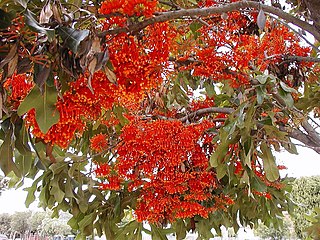
New Caledonia is a sui generis collectivity of overseas France in the southwest Pacific Ocean, south of Vanuatu, about 1,210 km (750 mi) east of Australia, and 17,000 km (11,000 mi) from Metropolitan France. The archipelago, part of the Melanesia subregion, includes the main island of Grande Terre, the Loyalty Islands, the Chesterfield Islands, the Belep archipelago, the Isle of Pines, and a few remote islets. The Chesterfield Islands are in the Coral Sea. French people, especially locals, call Grande Terre "Le Caillou".

The Santalales are an order of flowering plants with a cosmopolitan distribution, but heavily concentrated in tropical and subtropical regions. It derives its name from its type genus Santalum (sandalwood). Mistletoe is the common name for a number of parasitic plants within the order.

Araucaria is a genus of evergreen coniferous trees in the family Araucariaceae once widespread during the Jurassic and Cretaceous periods. There are 20 extant species in New Caledonia, Norfolk Island, eastern Australia, New Guinea, Argentina, Brazil and Chile.

Dactylanthus taylorii, commonly known in English as wood rose and in Māori as te pua o te rēinga, is a fully parasitic flowering plant, the only one endemic to New Zealand. The host tree responds to the presence of Dactylanthus by forming a burl-like structure that resembles a fluted wooden rose. When the flowers emerge on the forest floor, they are pollinated by a ground-foraging species of native bat.

Mekosuchinae is an extinct clade of crocodilians from the Cenozoic of Australasia. They represented the dominant group of crocodilians in the region during most of the Cenozoic. They first appear in the fossil record in the Eocene in Australia, and survived until the arrival of humans: in the Pleistocene in Australia and within the Holocene in the Pacific islands of Fiji, New Caledonia and Vanuatu.

Callitris pancheri is a plant species of the family Cupressaceae. It is endemic to New Caledonia, where it occurs in small, scattered population along rivers. It used to be placed in its own genus Neocallitropsis but molecular phylogenetic analysis indicated that it was nested within Callitris.

Schefflera is a genus of flowering plants in the family Araliaceae with 13 species native to New Zealand and some Pacific islands.

Nepenthes vieillardii is a species of pitcher plant endemic to the island of New Caledonia. Its distribution is the most easterly of any Nepenthes species. Its natural habitat is shrublands or forests, to about 900 metres (3,000 ft) altitude.

Stenocarpus is a genus of about 22 species of flowering plants in the family Proteaceae. They are trees or shrubs with variably-shaped leaves, zygomorphic, bisexual flowers, the floral tube opening on the lower side before separating into four parts, followed by fruit that is usually a narrow oblong or cylindrical follicle.

The Balanophoraceae are a subtropical to tropical family of obligate parasitic flowering plants, notable for their unusual development and formerly obscure affinities. In the broadest circumscription, the family consists of 16 genera. Alternatively, three genera may be split off into the segregate family Mystropetalaceae.

The blacktailed spurdog is a dogfish, a member of the family Squalidae, found around New Caledonia in the central Pacific Ocean, at depths from 320 to 320 m. Its length is up to 75 cm.
The New Caledonian wattled bat is a species of vesper bat, family Vespertilionidae. It is found only in New Caledonia.

Burretiokentia is a genus of palms (Arecaceae) endemic to New Caledonia containing five species. The relationships between Burretiokentia and some other genera of the tribe Basseliniinae including Physokentia and the New Caledonia endemic Cyphophoenix are not clear.

Oncotheca is a genus of tree endemic to New Caledonia. There are two species, Oncotheca balansae and Oncotheca humboldtiana.

The New Caledonia blossom bat is an uncommon species of megabat in the family Pteropodidae. The species lives in caves in northern New Caledonia, and forms colonies of up to 300.

The Diplodactylidae are a family in the suborder Gekkota (geckos), with over 150 species in 25 genera. These geckos occur in Australia, New Zealand, and New Caledonia. Diplodactylids are the most ecologically diverse and widespread family of geckos in both Australia and New Caledonia, and are the only family of geckos found in New Zealand. Three diplodactylid genera have recently been split into multiple new genera.
Clinosperma is a palm tree genus in the family Arecaceae.

Thonningia is a monotypic genus of flowering plants in the family Balanophoraceae containing the single species Thonningia sanguinea. It is distributed throughout much of southern and western Africa, particularly the tropical regions. Common names for the plant include ground pineapple. A familiar plant to humans, it has an extremely long list of common names in many African languages. Many names are inspired by the resemblance of the plant's inflorescence to a pineapple or palm tree. Some of the names can be translated as pineapple of the bush, duiker's kolanut, and crown of the ground.

Balanophora fungosa, sometimes known as fungus root is a flowering plant in the family Balanophoraceae and occurs in South Asia, Southeast Asia, Australia and some Pacific Islands. It is an obligate parasite growing on the roots of rainforest trees. The flowering structure is shaped like a puffball but in fact consists of a globe covered with thousands of tiny female flowers. The globe is surrounded at its base by a much smaller number of male flowers. In flower, the plant emits an odour resembling that of mice.

Rhipiceridae is a family of beetles found worldwide. The larva of rhipicerids are parasitoids of cicada nymphs. Rhipiceridae and Dascillidae form the super family Dascilloidea, within the Elateriformia.


















